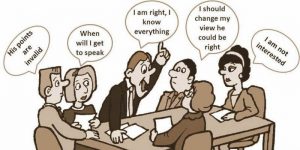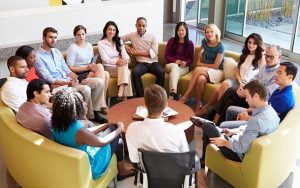Topical group discussion plays vital role in understanding a topic or issue. Discussing a topic with friends or classmates helps in learning the topic with precision. Group discussion on a topic involves sharing of learning by the participants which equally benefits all the participants. In my opinion it is one the best pedagogy.
Classroom discussions or debates enhance public speaking skills. A student develops critical thinking, research skills, organizing thoughts before talking and prioritization of information. They also present an opportunity to get students engaged with the material they are studying in different ways, forming and deconstructing both the opinions of others, and their own. But they can be a little demoralizing; teachers often think that they need to be experienced debaters themselves to get their students involved. This is not true. The truth is that there is no wrong or right way to debate in the classroom. The idea is to find out which way best suits the classes’ learning outcomes.
The composition of the class profile matters. The more diverse a class is the discussions benefit more. There is a difference between debate and group discussion: Debate is for argument and to attack to win while group discussion is to exchange ideas and opinions for a better understanding of a topic. Debates are supple, they can have as few or as many people involved in them as the need arises. Some like balloon debates. A balloon debate is a debate in which a number of speakers attempt to win the approval of an audience. The audience is invited to imagine that the speakers are flying in a hot-air balloon which is sinking and that someone must be thrown out if everyone is not to die. Each speaker has to make the case why they should not be thrown out of the balloon to save the remainder. Typically each participant speaks on behalf of a famous person, profession, fictional character, etc.
The other type of debate is known as alley debate or spin debate. A spin room also known as spin row or spin alley, is an area in which reporters can speak with debate participants and their representatives after a debate. The name refers to the fact that the participants will attempt to “spin” or influence the perception of the debate among the assembled reporters. Typically alley debates take place in college cafeterias or outside tea stalls, in libraries etc. Both balloon and alley debates can get large numbers of students involved.
The discussions must be topical in nature which evolves the current affairs. Discussing a topic with friends or classmates helps in learning the topic with perfection. Group discussion on a topic involves sharing of learning by the participants which equally benefits all the participants. Even case study topics can be very interesting.
A participant must approach the case by NOT beginning their thought process by impulsively thinking of what solution would best answer the question that follows the case, for we cannot solve a problem that we do not fully understand. The style must be like this: Situational analysis, Problem definition, Statement of objectives, Evaluation of alternatives, Recommendation or Alternatives.
Students find discussions disillusioned when faculty takes the lead. The faculty can discuss a caselet or a situation published in newspaper regarding famous corporate citizens and allows the students to talk among them. For example: ‘what are reasons of the fall of the star banker of ICICI Bank’? Or ‘Mallya’s extradition from UK can have what kinds of effects on Indian banking’?
The faculty must use a modular approach to topical coverage to force integration of topical ideas and concepts. The point here is simply that discussions should have designated themes or topics. The focus should be more specific than the generic.
The discussions must be developed from limited set of discussion questions that do not have “known answers.” If the questions are regularly returned to throughout the discussion, they effectively keep the discussion from drifting too far off topic.
Sufficient time must be allowed for discussion to develop. Students must be given time to review, think about, and prepare contributions. Students can be challenged to think about what others have said. They can be asked to summarize or indicate where they think the discussion is leading.
The faculty can turn by turn on different occasions ask the introverts in class to take lead roles. It is essential that students take the lead role in the evolution of a discussion; the faculty must limit his or her involvement in the discussion to a role as facilitator and provocateur and should do so only after other students decline the opportunity.
If need be, a reward system must be established to encourages interaction and peer critique. Students are motivated to participate if contributions to a discussion “count.” Faculties need to devise manageable grading systems and ones that make quality stipulations. The faculty can provide additional participation incentive through assessment.
Many participants in typical group discussions believe that they are expected to stick to a viewpoint defend it forcefully throughout the group discussion, and ‘win’ the discussion by knocking out other participants with brilliant arguments. Sometimes the group discussions become an ugly show with loud, rhetorical attacks amplified by aggressive body language. While uninhibited aggression is detrimental to all types of communication, a when group discussions turn into debate, it becomes vigorous interaction and arguments burst out from all directions. Such a process presumes adherence to the viewpoints or opinions which are arrived at extensive preparation, and usually do not change during the course of the discussions.
After the Discussion: The faculty must allow students to rethink, equip and improve whenever a discussion takes place. It must be a regular practice of pedagogy so that students learn the best way to approach the topic. They must take brief notes on how each discussion went and use these as the basis for reorganizing their strengths and weaknesses, for improving their presentation skills, rethinking the material included, or developing ideas for future teaching and research projects.














































